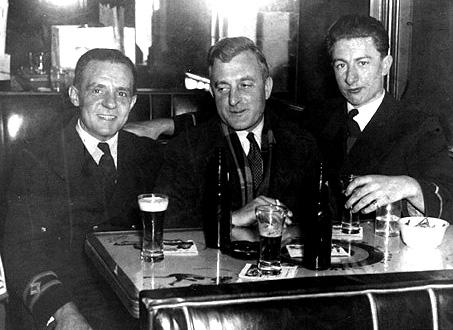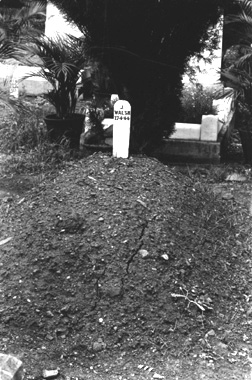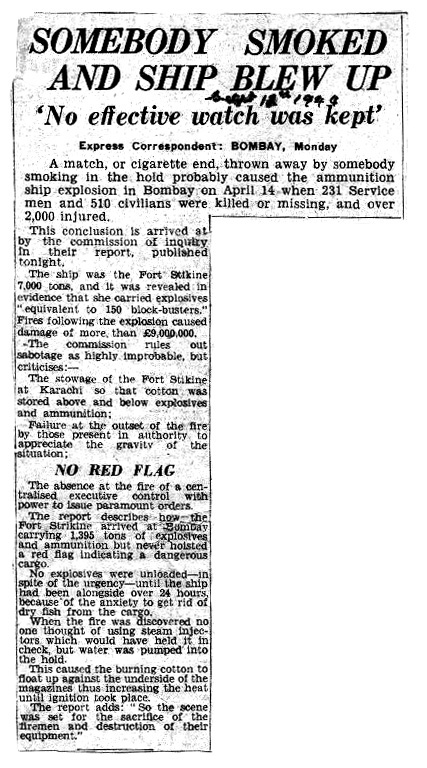EPILOGUE
After surviving the Bombay Explosion, John Garside remained

|
|
Among her explosive cargo
Fort Stikine
also carried
gold bars which were blasted all over the city.
Fort Stikine was one of 90
Canadian-built "Forts" which although
purchased by the USA, were
chartered to and registered in Britain
as part of the
"Lend-Lease"
deal.
The date of this
Toronto Star
clipping is unknown.
|
a DEMS gunner and he was soon assigned to
another merchant ship, the Norwegian tanker
MV
Braja
.
Braja
served
throughout the Pacific Ocean and John remained aboard her
for the duration of the war. Wartime secrecy surrounded
the catastrophe at Bombay and what happened there was not
public knowledge for a long time.
The two horrendous explosions aboard
Fort Stikine
had caused thousands of casualties
and untold devastation, but the clean-up
and salvage effort was so
massive that within six months the docks and surrounding
area had been re-built.
For many years afterwards, John wondered
if he had dreamed the whole horror or had at least exaggerated
his memories of it. It wasn't until 1992 when
Donald F. Patterson
of the Canadian
Merchant Navy Association gave him the article
"The Oceans, the Forts and the Parks"
by
L.A. Sawyer
and
W.H. Mitchell,
published in a 1966
issue of
Sea Breezes,
that John realized that his horrifying
memories were accurate.
A few months after his story had been up on the Internet,
John received an e-mail from a young British man,
Ian Walsh,
who turned out
to be the oldest grandson of
Fort Crevier's
Third Engineer
John Walsh.
John Walsh had
been standing next to John Garside on the deck of
Fort Crevier
just before
Fort Stikine
blew up and he had been killed instantly
by the explosion.
Ian Walsh generously
sent John Garside the following precious momentos which had
belonged to Ian's widowed
grandmother.
This first photo shows
John Walsh
and two
of his friends taking a break from their sea duties.
John is the gentleman on the left.

|
|
John Walsh (on left) and friends
|
This next photo is a copy of the letter
of condolence which
Captain Emrys Jenkins,
the master
of Fort Crevier,
wrote to Mrs. Walsh after her husband's death.

|
|
Captain Jenkin's Letter
|
This next photo shows John Walsh's grave as it looked
in April 1944. After the war was over John was
commemorated by a
Special Memorial
which was placed in the
Kirkee (also known as
Khadki)
Military Cemetery at
Poona
(now Pune), India.
Pune is a university city of over
two million people and it is located about 115 miles
south-east of
Bombay on the Deccan Plateau.
Bombay is now called Mumbai.

|
|
John Walsh's Grave, Sewri Cemetery, Bombay
|
On April 14th, 2002 -- the
58th Anniversary of the Bombay Explosion --
John Garside received a letter from
Michael Wale
the eldest grandson of survivor
George E. Todd.
Michael wrote that his Grandfather
George was
a foreman shipwright with the
P&O
Shipping Company.
During the war he worked in Bombay for
P&O's
subsidiary company
Mazagaon Dock Limited
which
looked after the
Prince's and Victoria docks.
Like John Garside, George E. Todd
not only witnessed the Bombay Explosion,
but also had a narrow escape from death himself.
Michael Wale kindly sent John the following letter
giving the harrowing details of
what
his Grandfather George
went through on that day and
how it affected him and his family
in later life.
|
April 14th, 2002
A few years ago I was given a copy of an interview with my
Grandfather that appeared in the Victoria Daily Colonist
newspaper. The article was dated March 4, 1973 and recalls
his personal experiences from that day.
My Grandfather was the senior civilian official for the
shipyard and was responsible for the ships
Fort Stikine,
Jalapadma,
Baroda and
El Hind.
According to the article, at 1:30, while returning
from lunch, he was notified that a fire had broken
out aboard the
Fort Stikine. My Grandfather did not
known that ammunition was aboard until 3:00 when the
fire had become out of control and he was notified of
the matter. A decision was made to scuttle the ship and
a squad of shipwrights were sent to assist the fire
fighters in their efforts to cut through the hull.
An evacuation of the docks was also ordered. At this
time my Grandfather was standing on deck of the
El Hind, two berths away from the
Fort Stikine when
all hell broke loose.
According to the article, the concussion of the blast blew
my Grandfather through a cabin door and burnt most of his
skin on chest and shoulder. The blast also snapped the
El Hind of her mooring lines. Caught in the explosion's
vortex, she began to slip towards the blazing
Stikine.
As she drew closer the El Hind began to catch fire and the
men onboard decided to lower the lifeboats, some of which
were by now already aflame. This is when the second explosion
occurred. I remember my Grandfather telling me of a man
standing next to him at the time that was split in two by
a piece of falling debris. The survivors aboard the
El Hind,
unable to find a means of escape gathered on deck. Someone
had found some water and cigarettes in one of the cabins
and group huddled together when a landing craft bumped
along the side. The craft had set adrift and somehow,
by chance had found them. They were quick to throw a rope
over the ships side and climb down to the craft, start
its engine and navigate their way through the harbour to
safety. My grandfather and his companions then staggered
through the Red Gate towards the city.
My Grandfather was hospitalised for two weeks after the explosions.
Doctors removed 70 splinters of wood and steel from his body.
My Grandmother and Mother joined him in India a year later.
My aunt, Ann was born in Bombay a few years later. They remained
in India until 1953, experiencing first-hand the rise of Indian
Independence and the Royal Indian Navy mutiny before returning
to England. Two years later My Grandparents emigrated to
Victoria, British Columbia, Canada,
where George became a charge-hand at Yarrows
Shipyard.
He passed away several years later,
but I can still remember his stories of India
and the experiences he indured.
I remember him showing me his chest and legs,
still spotted with shrapenel from the explosion.
As a teenager I returned to India with
my parents and two brothers in 1984. We visited the
Mazagaon Dock area and the compound in which my Mother
had lived in as a child. The residences had remained
unchanged, however they were slated for demolition the
following year.
My Grandfather is survived by his wife Vicki,
of Victoria, British Columbia,
who at the age of 84 has just recently gone 'on line'.
I work in the film industry and have often thought this
story would make a good film. I have begun the process
of collecting information about this time in Indian history
and would appreciate hearing from anyone with
suggestions or sources about the Bombay Explosion.
Michael Wale
Vancouver, B.C.
E-Mail:
hopewale@telus.net
|
In the first week of July 2002 John Garside received two
letters from retired Shipmaster
Vic Pitcher of Scotland. Although
Captain Pitcher did
not witness the Bombay Explosion himself,
17 years later he sailed with
one of the Explosion's most amazing survivors,
Captain John (Jack) Longmire.
Here are excerpts from Vic's letters which tell the
unforgetable tale of Captain Longmire:
Vic Pitcher
wrote:
"Back in 1961 I was the 2nd Mate of a Hong Kong registered ship
East Breeze
belonging to John Manners of Hong Kong.
The Master was
Captain J. H. Longmire,
who was very much
a
"China Coast Man", having sailed out of
Shanghai before the war and Hong Kong
post-war. At the time
I served with him Captain Longmire was resident
in the town of
Wickepin, West Australia.
During the war
Captain Longmire
was based at Bombay
where he was serving
as a Lieutenant Commander
in the Royal Navy.
At the time of the Explosion
he was a Salvage Officer
and was alongside
the
Fort Stikine
when she blew up.
He was later recovered, still alive,
from a cart full of bodies.
Vic also came across a brief reference
to Captain Longmire's ordeal
in
John Ennis' book Bombay Explosion,
which Vic found in a London
library in the early 1970's.
Vic Pitcher can be reached at the e-mail
address of
Vjmandarin@aol.com
|
|
UPDATE APRIL 2003: Commander Longmire's son,
John Longmire, would like to hear from anyone with connections to the Bombay Explosion, and he can be reached at
clitheroejl@bigpond.com.
|
This last photo -- shown below -- was sent to John Garside by
Ian Walsh. It is a copy of
the newspaper article, dated September 12th, 1944,
which summarized the
Commission of Inquiry into the Bombay
Explosion. The Bombay firemen referred
to in this article
and in Michael Wale's above letter, had
courageously remained
by the burning ship and
were killed by the second explosion.
(For more on the heroic
Bombay firemen see
John H. Harding's
letter
under "Recommended Reading" below).

|
|
Summary of the Inquiry
|
The exact cause of the Bombay Explosion will never be known for
sure, but one current theory is that the initial fire
was
due to the cargo of cotton bales which had been loaded at
Karachi. Cotton is capable of bursting into flames all
on its own
and it is possible that just
such a "spontaneous combustion" was the cause
of the fire which led to the two terrible explosions aboard
Fort Stikine.
Whatever the cause, there is no doubt that the Bombay
Explosion was one of the greatest disasters
of the Twentieth Century.
In his book A Great Fleet of Ships:
The Canadian Forts and Parks, historian
S.C. Heal examined the Bombay Explosion and came to the
conclusion that it was
"probably the largest single disaster
of its type on the Allied side during
the war",
and second only to the largest manmade blast
before the nuclear age --
the December 6th, 1917 explosion of the
SS
Mont Blanc
at Halifax,
Nova Scotia,
in which over 1,700 died and over 4,000 more were
injured.
John Garside's entire life has
been deeply touched by the cataclysmic
events which he witnessed on April 14th, 1944. The lives
of John Walsh's widow and family were irrevocably
altered for generations
by his death. George E. Todd
never fully recovered
from his terrible injuries
and Captain Longmire
must have been haunted
for the rest of his life
by his ordeal.
The families of the dockyard workers
and firemen as well as
countless thousands of other families --
in Bombay, throughout India and around the world --
were also devastated
by the Bombay Explosion.
It is important that the rest of the world not forget this
seemingly long-ago, but all too recent tragedy of war.
THE END

RECOMMENDED READING:
Bombay Explosion
by John Ennis. Published
in London, England, by Cassell in 1959. An American
edition entitled
The Great Bombay Explosion
was published the same year
in New York by Duell, Sloan, and
Pearce.
John Garside highly recommends this
book as does John H. Harding (see below).
|
|
"Quenching the Fires of Hell" by John H. Harding.
Published by the
U.S. Naval Institute
of Annapolis, Maryland in the February 2002 edition of
Naval History Magazine.
John H. Harding who served with the US Army Air Forces
during WWII, was one of the heroic
rescue workers of the Bombay Explosion. In
"Quenching the Fires of Hell"
he gives a
very moving account of the disaster and its aftermath.
In December 2001, after coming across John's page on
the Internet, John H. Harding wrote John Garside a
series of moving letters -- an excerpt of one
of them is printed below:
Excerpts from
John H. Harding's Letter
"When I think of the courage of the firemen
it reminds me of British and Indian
(The Gurkha Rifles)
action at the
Battle of Kohima
in Burma in the Second World War. The battle,
which was where the Japanese thrust into India
was stopped,
produced a poignant and singularly beautiful verse,
the
"Kohima Prayer":
"When you go home, tell them of us and say,
For your tomorrow, we gave our today."
Credit for writing the "Kohima Prayer" is given to a young
British solder who is buried at Kohima.
The cemetery
has been described as 'serene and beautiful, located
on a hill overlooking the capital'. I would add
that it lies amidst silence and beauty,
a tribute to the young men who dwell within its confines.
There is a variation of the "Kohima Prayer"
chiseled into the front of the
Bombay Fire Brigade's old headquarters
building on Bycula Road in Bombay.
This effort was done at the behest of my friend
Lovejoy Mehervanjee,
Chief Fire Officer, retired,
of the Brigade. Lovejoy, who is a very nice guy from the
old school, every inch the gentleman, supplied
me with the photos I used in my Explosion story."
John H. Harding
May 25th, 2002
RECOMMENDED LINK:
Bombay Photo Images [Mumbai]: The Bombay Explosion, 1944
This blog, dated February 2, 2011, provides
detailed information, maps and photos
about the Bombay Explosion.
The webpage also features personal
eye-witness memories of the disaster, including
the account by Derek P. Ings
who was Assistant Purser aboard
HMT Chantilly at the time of the Explosion.
|
John Garside can be reached at
jgarside187@gmail.com
John's pages are maintained by Maureen Venzi
and they are part of the
Allied Merchant Navy of WWII
website.
|
